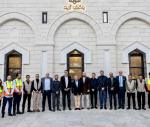You are here
North Korea’s Incheon landing
Oct 12,2014 - Last updated at Oct 12,2014
North Koreans relish the element of surprise when they get to choose the stage and command the theatrics. The unexpected visit of three top leaders of the Democratic People’s Republic of Korea (DPRK) to the closing ceremony of the Asian Games in Incheon last week, stole the show from the athletes.
The three visitors — Hwang Pyong-so, vice chairman of the powerful National Defence Commission, and two other senior officials from the Workers’ Party of Korea, Choe Ryong-hae and Kim Yang-gon — met with the South Korean prime minister, national security adviser to the president, and the head of the ministry of unification.
It was a rather merry occasion, with leaders on both sides promising to meet again next month and offering abundant smiles and handshakes for the cameras.
Korea observers are wondering what this means for the future of the inter-Korean relationship. Is the government in Pyongyang trying to send a message to South Korea, the United States, and China? Will the six-party talks on North Korea’s nuclear programme, which have been defunct since 2009, resume?
The clearest answer is that there is no clear answer. In recent months, North Korea has been exploring new diplomatic territory, with high-level officials engaging Europe, Japan, and the United Nations General Assembly in New York.
Last week, the DPRK mission to the UN even responded to a highly critical human rights report by acknowledging its labour camps (which it defended as a means of “re-education” and “reform”).
North Korea has been far less forthcoming about its intentions. It remains to be seen whether it seeks to engage the rest of the world in a constructive and sustained manner, or whether DPRK officials and diplomats are merely putting a good face forward to divert international attention from their country’s reputation as a nuclear weapons-monger and human rights violator.
Indeed, the visit to Incheon comes within a context of mixed messages.
Two days before the North Korean delegation arrived, the Committee for the Peaceful Reunification of Korea (CPRK), which is officially part of the Korean Workers Party, denounced the “South Korean puppet forces for seriously violating the North-South joint declarations and pushing North-South ties into the worst catastrophe”.
On the day of the Incheon visit, North Korea’s state news agency continued the bellicose and derogatory language towards South Korea and the US: “Lurking behind this is an ulterior design of the US to [prod more] zealously the South Korean puppet forces into escalating the confrontation with the DPRK in a bid to strain the situation to an extreme pitch and ignite [a] second Korean war.”
And a mere two days before the Incheon visit, the DPRK ambassador to the United Nations said that China, Russia, and North Korea stand ready to restart the six-party talks. In fact, there is no coordinated action among the three countries; indeed, relations between China and North Korea remain frigid.
Rather, North Korea seems to be posing a non-existent united front in order to put pressure on the US to soften its stance towards the DPRK regarding its nuclear programme and human-rights record, and to reconsider economic sanctions against the North. Seen in this light, the visit to Incheon was a way to persuade Seoul to put pressure on the US to play nice.
Adding to the mixed messages is the symbolic date of October 4, the seventh anniversary of the 2007 declaration on inter-Korean cooperation signed by the late South Korean president Roh Moo-hyun and the late North Korean leader Kim Jong-il.
This could be a positive reminder that the DPRK is seeking to pursue some of the agreements contained in that declaration.
On the other hand, the North could be taking advantage of criticism of South Korean President Park Geun-hye by her opponents on the left for failing to include the October 4 agreement in her five-year plan regarding inter-Korean relations.
Complicating matters further, military theatrics resumed just two days after the friendly visit to Incheon, when a boat from the DPRK crossed the disputed Northern Limit Line (NLL) in the Yellow Sea, inciting a 10-minute firefight with South Korean forces.
What explains this contradictory behaviour? The North may have wanted to emphasise that its friendliness towards the South should not be interpreted as weakness. Or perhaps it was attempting to determine whether its overtures had led South Korea to soften its stance towards the DPRK. (South Korea’s response — 94 machine-gun rounds — was unambiguous.)
In any case, the incursion may signal that the NLL will soon feature on the agenda of inter-Korean talks.
The DPRK’s decision to visit Incheon was highly symbolic, for it was there during the Korean war that US and South Korean troops, following a daring landing led by General Douglas MacArthur, defeated the North Korean People’s Army and pushed it back beyond the 38th parallel.
Whether the recent surprise landing will mark the port city as the starting point of a path to reconciliation and peace on the Peninsula remains to be seen.
The writer is chair of Korea Studies and senior fellow at the Centre for East Asia Policy Studies at the Brookings Institution. ©Project Syndicate, 2014. www.project-syndicate.org












